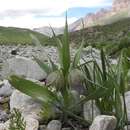tr
kırıntılardaki isimler


The Lilioideae are a subfamily of monocotyledonous perennial, herbaceous mainly bulbous flowering plants in the lily family, Liliaceae. They are found predominantly in the temperate and colder regions of the Northern Hemisphere, particularly East Asia and North America. The subfamily includes two tribes. They are of economic importance, particularly the lilies and tulips.
Lilioideae genera are relatively homogeneous and distinct from the other two Liliaceae subfamilies (Calochortoideae and Streptopoideae). They are perennial herbaceous flowering plants that are mainly bulbous (Lilieae) with contractile roots, but may be rhizomatous (Medeoleae). Stems unbranched, leaves with parallel venation. Flowers are large and showy. The embryo sac (megagametophyte) is of the Fritillaria-type (tetrasporic). Capsule septicidal, seeds often flattened, exotesta palisaded or lignified. The seeds of Medeoleae are striate.[2] Chromosome number may be 7 (Medeoleae),[3] 9, or 11–14, with a highly variable length (2.2 - 27 µm).
The term was introduced by Amos Eaton in his Botanical Dictionary in 1836.[4] Engler and Prantl included it as one of the eleven subfamilies of Liliaceae.[5] In 1927, Buxbaum's treatment of the subfamily included three tribes; Lloydieae (Gagea, Lloydia and Szechenya and Giradiella — both now included in Lloydia), Tulipeae: (Erythronium, Tulipa and Eduardoregalia — now part of Tulipa) and Lilieae (Korolkowia, Fritillaria, Notholirion, Cardiocrinum, Nomocharis and Lilium).[6][7]
In the phylogenetic era, the subfamily Lilioideae has been circumscribed in both a broad (sensu lato, or s.l.) and narrow (sensu stricto, or s.s.) sense. Tamura,[8] and others[9] have defined Lilioideae s.s. (or sensu Tamura) to include only the tribes Tulipeae and Lilieae. However other authorities including the Angiosperm Phylogeny Website (APWeb)[10] define Lilioideae s.l. to also include the Medeoleae (while subsuming the Tulipae into Lilieae). In the s.s. usage, the Medeoleae are treated as a separate subfamily, the Medeoloideae.
The subfamily Lilioideae includes ten genera and about 535 species. The largest genera are Gagea (200), Fritillaria (130), Lilium (110), and Tulipa (75 species).
The Lilioideae are a subfamily of monocotyledonous perennial, herbaceous mainly bulbous flowering plants in the lily family, Liliaceae. They are found predominantly in the temperate and colder regions of the Northern Hemisphere, particularly East Asia and North America. The subfamily includes two tribes. They are of economic importance, particularly the lilies and tulips.
Lilioideae er undirætt fjölærra einkímblöðunga, jurtkenndra, aðallega laukmyndandi blómstrandi plantna í Liljuætt. Þær eru aðallega á tempruðum og kaldari svæðum Norðurhvels, sérstaklega Austur Asíu og Norður Ameríku. Undirættin inniheldur tvo ættflokka. Þeir eru mikilvægir efnahagslega, sérstaklega liljur og túlípanar.
Lilliodeae undirættin er frekar einsleit og aðskilin frá hinum tvemur Liliaceae undirættunum (Calochortoideae og Streptopoideae). Þetta eru fjölærar, jurtkenndar, blómstrandi plöntur sem eru aðallega laukkenndar (Lilieae) með samdráttarrótum, en geta verið með jarðstöngla (Medeoleae). Stönglar ógreindir, blöð beinstrengjótt. Blóm eru stór og áberandi. Hýðisaldinið septicidal, fræin oftast flöt. Litninga tala getur verið 7 (Medeoleae),[2] 9, eða 11-14, með mjög breytilega lengd (2.2 - 27 µm).
Lilioideae undirættin inniheldur 10 ættkvíslir og um 535 tegundir. Stærstu ættkvíslirnar eru Gagea (200), Fritillaria (130), Lilium (110), og Tulipa (75 tegundir).
Lilioideae er undirætt fjölærra einkímblöðunga, jurtkenndra, aðallega laukmyndandi blómstrandi plantna í Liljuætt. Þær eru aðallega á tempruðum og kaldari svæðum Norðurhvels, sérstaklega Austur Asíu og Norður Ameríku. Undirættin inniheldur tvo ættflokka. Þeir eru mikilvægir efnahagslega, sérstaklega liljur og túlípanar.